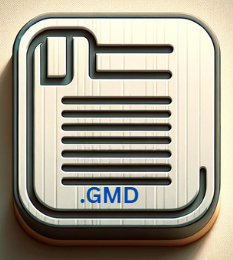.GMD File Extension

Geometry Dash Level
| Developer | HJfod |
| Popularity | |
| Category | Game Files |
| Format | .GMD |
| Cross Platform | Update Soon |
What is an GMD file?
.GMD file extension holds a unique place. These files, often encountered by professionals and hobbyists in specific fields, are associated with distinct applications and purposes.
This article aims to provide a comprehensive overview of the .GMD file extension, delving into its origin, history, technical structure, advantages, disadvantages, and guidelines on how to convert and open these files across various operating systems.
More Information.
The history of the .GMD file extension is intertwined with the development of the software that utilizes it. In the realm of game development.
.GMD files were initially created to store 3D model data for video games. This need arose from the gaming industry’s evolution towards more complex and detailed 3D environments.
In other fields, like music composition, .GMD files may have been developed to store musical scores or digital sound information.
Origin Of This File.
The .GMD file extension originated from specific software applications, each using it for their distinct purposes.
This diversity in origin is partly why understanding .GMD files require context about the specific application it is associated with.
Some .GMD files are known to be associated with game development, where they represent game model data, while others might be linked to music composition software or specialized scientific applications.
File Structure Technical Specification.
The technical structure of a .GMD file can vary significantly depending on the software it is associated with. Generally, these files are binary and require specific programs to read and interpret their contents.
In a game development context, a .GMD file might include 3D model coordinates, textures, and animation data. For music-related .GMD files, the structure could comprise musical notations, instrument data, and timing information.
How to Convert the File?
Converting .GMD files can be a complex process, dependent largely on the specific type of .GMD file you are dealing with.
Here’s a detailed guide on how to approach this conversion:
- Identify the .GMD File Type: Since .GMD files are associated with different applications (like game development, music composition, or other specialized software), the first step is to identify the exact type of .GMD file you have. This can typically be done by looking at the software used to create the file or the context in which you received it.
- Find the Appropriate Conversion Software: Once you know the specific type of .GMD file, you need to find software that can open it and convert it to a more universal format. For example, for a .GMD file related to game development, you might need a 3D modeling tool that can open and export the file to formats like .OBJ or .FBX. For music-related .GMD files, a music composition program that can convert to MIDI or WAV files would be required.
- Install the Conversion Software: After identifying the right tool, download and install it on your computer. Ensure that the software is compatible with your operating system.
- Open the .GMD File in the Software: Launch the conversion software and use its file-opening feature to open the .GMD file. This step might involve navigating to the file location and selecting the file.
- Convert the File: Once the .GMD file is open in the program, look for an option to export or save as a different file format. Choose the desired format that you want to convert the .GMD file into. This could be a common format like .PDF, .MP3, .WAV, .OBJ, etc., depending on what the .GMD file contains the capabilities of the software.
- Save the Converted File: After selecting the export format, save the new file to your preferred location. Ensure that you name it appropriately and keep track of where you save it for easy access.
Advantages And Disadvantages.
The advantages of .GMD files are largely context-specific. In game development, they allow for efficient storage and manipulation of complex 3D models. For music composition, they provide a format for creating and sharing digital music scores.
The disadvantages are notable. The primary challenge with .GMD files have a software-specific nature, which often leads to compatibility issues. This means that without the appropriate software, these files are virtually inaccessible.
How to Open GMD?
Open In Windows
- Identify the software associated with the .GMD file.
- Download and install the necessary application. If it’s a specialized tool, it might be available on the software developer’s website.
- Right-click on the .GMD file, select ‘Open with’, and choose the installed application. If the application doesn’t appear in the list, navigate to it manually.
Open In Linux
- Identify the suitable software for opening the .GMD file.
- Install the software using your Linux distribution’s package manager, or download it from the official website. If there’s no Linux version, use a compatibility layer like Wine or a virtual machine running Windows.
- Use the terminal or file manager to open the .GMD file with the installed software. You might need to use specific commands in the terminal if the software doesn’t have a graphical user interface.
Open In MAC
- Determine the correct application for the .GMD file type.
- Download and install the Mac version of the software. In case there isn’t a Mac version available, consider using a compatibility tool like Wine.
- Right-click on the .GMD file and select ‘Open With’ to choose the installed software. If it’s not listed, use the ‘Other’ option to find and select the application.













